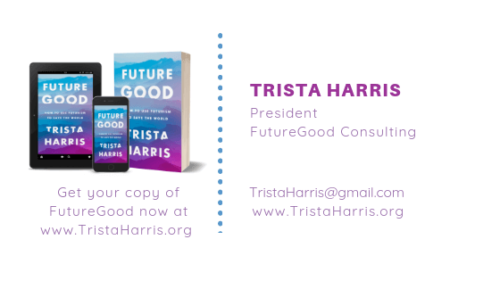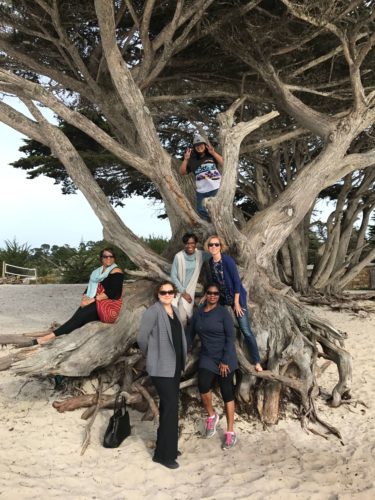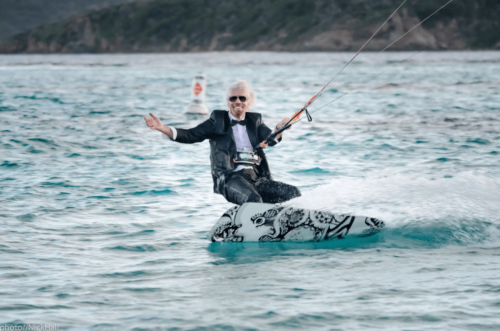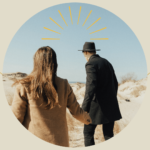Philanthropic futurist Trista Harris is the president of FutureGood, a consultancy that helps visionary leaders build a better future. She is also the author of FutureGood: How to Use Futurism to Save the World and co-author of How to Become a Nonprofit Rockstar: 50 Ways to Accelerate Your Career.
Tell us about yourself.
I will “MacGyver” my way into the most unexpected situations to discover the signals of the future that will help make the world a better place.
I once negotiated an interview with Sir Richard Branson and was later invited to his home on Necker Island. During this adventure, I got my DNA sequenced and was mobbed by a conspiracy of lemurs. I even watched Richard kitesurfing in a tuxedo and gave a speech on the future of doing good. I’d have thought it was a fever dream if I didn’t have pictures!
I’ve been working in nonprofits since I was 13 years old. Before FutureGood, I was the president of a community of grant makers that gave away $1.5 billion a year.
To develop my futurism skills, I learned about scenario planning at Oxford University and hung out with technologists at Singularity University. I also went to Amy Webb’s Future History Festival and trained with the team at the Institute for the Future.
Tell us about your business.
FutureGood helps leaders build a better future in a variety of ways. First, through consulting: We do strategic planning and trend development.
One piece of work I’m excited about is helping people create an equitable future within their organization. This is done by aligning their processes and procedures with their equity vision.
Second, through speaking: I speak across the country and around the world on how to bring futurism to work.
Third, through Mastermind Retreats. I host Mastermind Retreats for women who are trying to clarify their purpose or need a brilliant network of supporters to level up.
Fourth, through bespoke team retreats. A new piece of my business is coordinating and facilitating retreats for teams working together to envision a new future.
On these team retreats, we do long-term visioning and determine where their future vision lives in their current reality. Then, we develop a plan to get there. I believe people do their best work when they’re refreshed, so these retreats happen in beautiful locations throughout the world.
Fifth, through field trips to the future. There is a saying that the future already exists; it just isn’t evenly distributed. So, I bring visionary leaders to locations around the world to see the future in action.
I’ve led groups to Sweden to see the future of early-childhood education, Spain to see the future of city development, and Brazil to see the future of equity. I’m also hosting a trip this summer to Nukutepipi, French Polynesia, to teach people how to harness exponential trends and art to build a better future.
Tell us more about your Mastermind Retreats.
I created the FutureGood Mastermind Retreat because I was burned out and in need of a place to refresh myself. Masterminds are a concept developed by Napoleon Hill in his 1937 book Think and Grow Rich. He describes it as “the coordination of knowledge and effort, in a spirit of harmony, between two or more people, for the attainment of a definite purpose.”
The FutureGood Mastermind Retreat was built around the idea that we could each create a dent in the world by offering each other support, accountability, and a space to retreat and refresh ourselves.
For our first retreat, I rented a beautiful mansion near the ocean in Pacific Grove, California, and five women and I spent five days setting powerful goals and helping each other develop strategies to accomplish them.
More than a hundred women are now a part of the FutureGood Network, and the power of women taking time for themselves and their goals is continuing to grow.
How did you get started in philanthropy and nonprofits?
Most kids in second grade draw pictures of ponies or their dream house. I used to draw floor plans of community centers.
When I was about eight years old, my mom started volunteering as a costume designer for a local theater. She brought me with her to the practices at a local community center. I had lots of time to explore all the nooks and crannies there, and I remember being so impressed with all the services offered.
From then on, I was positive I wanted to work for a nonprofit organization.
Since I was 13 years old, I have worked on programs, operations, fundraising, grant making, and public policy in the nonprofit sector. I’ve supported more than 5,000 nonprofit organizations in various capacities.
Describe futurism in the social sector.
The government, the military, and the private sector have all used the powerful tools of futurism extensively to strengthen their ability to understand what is coming next. I think it’s time the social sector took advantage of those same tools to strengthen our work of making the world a better place.
The world is changing at an exponential pace, and I believe the social sector needs to help people through this transition so we can all build our ideal future together.
You’ve written two incredible books. What inspired you to write How to Become a Nonprofit Rockstar? Also, tell us more about your recent book, FutureGood.
I wrote How to Become a Nonprofit Rockstar because I would have wanted that book to exist when I got started in nonprofits. Schools teach you technical skills, but the soft skills of branding, networking, building the ability to lead, and finding balance were completely missing. I was seeing too many amazing people leave the social sector because they didn’t have those soft skills, and I wanted to offer a solution.

I wrote FutureGood to help fill in the gaps in our collective knowledge about what to do with uncertainty about the future. An increasing rate of change makes the already challenging business of doing good even more difficult.
Small nonprofits, national service agencies, foundations, think tanks, and social entrepreneurs all are trying to make the world a better place. But they’re using yesterday’s information to do so. I skipped the jargon to make this book accessible to people who care about making our communities better.
Let’s dive deeper into your journey. What are some challenges you’ve experienced along the way?
Early in my career, one frustration I experienced was thinking I didn’t have a voice in the organizations I was part of. I felt like a cog in the wheel. I had to learn how to “manage up” and make myself invaluable to my leaders.
Now, later in my career, the challenge is not trying to do everything. Some great advice I got was to do only the things only I can do. When you develop a lot of skills, it’s easy to feel like delegation will take more time than it’s worth, so you format spreadsheets or write copy for a conference yourself.
I have to constantly remind myself to delegate tasks to brilliant people who will do them a lot better than I will. That way, I can focus my time and energy on bringing connections or visionary leadership to an organization or a project.
We often see only the glimmering success stories. What was your process like? What were some of your struggles and hardships?
I think my biggest recent hardship was stepping away from an organization I loved and a team that was having a really positive impact on the world to focus my energies full-time on philanthropic futurism.
It’s really scary to step away from the known and comfortable, where you have a fancy title, to start your own thing. It created a lot of sleepless nights.
But at some point, the pain of not blooming was greater than the uncertainty and pain of blooming, so I made the jump.
How have you stayed motivated throughout your journey?
I think a lot about the world I’m leaving for my children through my work. When I get overwhelmed or frustrated, I lean on that purpose.
Who have you leaned on for support? Do you still lean on the same people?
There is a saying that you are the average of your five closest friends. I spend a lot of time with amazing people because I know it will help me have a bigger impact on the issues and communities I care about – plus, they are a lot of fun to be around!

I lean on a variety of groups for support. My Mastermind group is my go-to. They are brilliant women committed to making the world a better place and supporting each other in the process. They are a wealth of inspiration.
I also have a monthly lunch with women from a variety of sectors. We help each other with negotiation, goal setting, and balancing being a leader with being a great spouse.
I also host monthly group networking meetings with people who want to pick my brain or need advice. They gain a lot from the perspectives of the other people in the group, and I build my network without filling my schedule with coffees where I crisscross the city.
Who are some of your mentors?
Angela Glover Blackwell: Angela is the founder of PolicyLink, and she is a brilliant person who helps people build a more equitable future. I’ve learned a ton from her on how to be a supportive wife while moving my own dreams forward.
Sir Richard Branson: I’ve learned so much from him about setting crazy goals, building a team to support that vision, and, most importantly, balancing fun with impact.
Peter Diamandis: Peter has a really positive view of what sort of future we can create if we leverage technology to help the broadest number of people. I am constantly stretched by his thinking.
I’m also a strong believer in having imaginary mentors. I’ve learned so much from watching people who don’t know me at all. I examine how they brand themselves, the positions they’ve taken, the things they write about, and how they treat people — all important life lessons for my own career. My current imaginary mentors are Oprah, Questlove, and Brené Brown.
What was your big breakthrough moment?
When I was 29, I applied for a position as an executive director of a social justice foundation. I was lucky enough to get selected for the role.
In that process, I realized I needed to start letting other people tell me no instead of not going after opportunities I believed other people wouldn’t select me for.
Fortune favors the brave.
Then in 2015, I set a goal to interview Sir Richard Branson about his future-focused philanthropy. In 2016, I got an unexpected invitation to join a conference on the convergence of future technologies that was happening on Necker Island, which is Sir Richard Branson’s private Island.
I was able to present on the future of doing good and spend time with a group of extraordinary technologists, entrepreneurs, scientists, and Sir Richard Branson himself.

As I was leaving the island, I had the most surreal experience. The boat I was leaving on stopped. And the driver said, “I don’t want to hit my boss with the boat.”
I looked ahead and saw Sir Richard Branson, wearing a full tuxedo, kitesurfing in the ocean ahead of us.
As he zigzagged back and forth, we got a chance to speed ahead of him. As I looked back, he let go of the kite with one hand and waved to me as I left. It was then I saw the photographer on the beach who was shooting him kitesurfing for a photo spread.

I’m not telling you this story because it’s the coolest thing that has happened to me. (It is.) I’m sharing this because you can sometimes create the future you want by having a clear vision of what success looks like.
Once I knew success was connecting personally with Sir Richard Branson and learning about his philanthropy, I noticed opportunities that would make that future possible. I think it can work the same for you.
As you get clearer about the future you are working to create, you start noticing opportunities and making decisions today that will make that future possible. That is the real benefit of having a future-focused mindset.
Did you almost give up at any point? If so, what led to that, and how did you persevere?
I’ve had a million moments when I wanted to give up. But I’ve never had the illusion that there was an easier path for me.
When I was taking the job leading the Minnesota Council on Foundations, my husband asked if I was sure I wanted such a visible, high-stress role. I told him all jobs are high stress. He disagreed and asked me to describe a low-stress job I’d had. I couldn’t think of one.
Then he asked me to describe my first job. I told him I had been a waitress. And he said, “Well, that couldn’t have been so stressful.”
I told him I used to wake up with an arm in the air like I was holding a tray. I was worried I had forgotten to bring someone their orange juice!
So he told me to take the biggest job I could find. I do everything 150 percent, so I might as well have a big impact while doing it.
What is something you wish you knew when starting out?
Take great care of yourself while you do this work. Learn to meditate and develop a consistent exercise practice to sustain you in the long term.
What are some of your daily rituals and habits?
Meditation gives me the mental space to examine my thinking in a new way and create space for new ideas. I was only able to start meditating consistently after reading Hal Elrod’s book The Miracle Morning, which is about changing your morning routine to the following six steps, which I do most days:
Silence: I meditate during this time.
Affirmations: I have a short statement: “I have the time, energy, and clarity of purpose to make big things happen.”
Visualizations: I visualize what I want my day to look like.
Exercise: I move for a little bit — yoga or the seven-minute workout on my Amazon Alexa.
Reading: I read something that inspires me or teaches me something new.
Scribing: I journal about what I’m grateful for.
How can our readers make an impact in the lives of others?
Decide what is the one thing the world needs, that you care deeply about and that you love doing. Do that thing.
What does audacity mean to you?
I think it’s a willingness to be bold and take big risks to achieve your purpose.
Find Trista Harris at:
Facebook: Trista Harris
Instagram: @tristaharris




